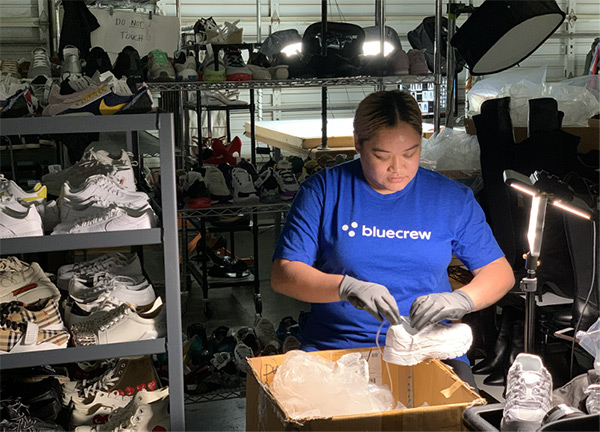Why light industrial organizations need to take a page from the Gig Economy playbook.
By Matt Laurinas, Chief Customer Officer at Bluecrew
Companies from coast to coast are experiencing staffing challenges as they move out of their pandemic-level staffing models and work toward operating at full capacity. Employers report that it is 36% harder to find qualified employees today than in 2018, despite the larger pool of available workers.
One possible reason for this continued shortage is the recent explosion of and reliance on the “Gig Economy.” During the pandemic, gig work such as driving (Uber, Lyft), delivery services (Amazon, DoorDash), and shopping services (Instacart, Fresh Direct) became so much more popular in terms of job opportunities, that 16% of the American workforce has worked for a gig platform, including 30% of all adults 18-29 years old.
For employers in the light industrial space, the harsh reality is that when it comes to staffing, you are competing with an entirely new set of options for today’s hourly workers.

The motivation and desires of the average worker have changed dramatically over the past two years. Some of the most important things sought out by today’s light industrial workers include:
Schedule Control + Transparency: Remote work isn’t generally an option for most light industrial positions, but according to a recent survey, shift and schedule flexibility have become one of the top three factors in a worker’s decision both about the job they choose and whether or not to stay at a job.
Higher Pay: Rising inflation and the shifting employee/employer power dynamics mean it will cost more to attract quality workers. The average wage per hour jumped $2.54 per hour in the light industrial space, but that number will need to increase to keep pace with the economy and the competition.
Recognition & Opportunity for Advancement: Hourly workers like to be rewarded for a job well done, and are more likely to take a job that recognizes their efforts and offers the opportunity to up-level their role. Career advancement is no longer something reserved for office-bound, 9-5 jobs; the hourly workforce is officially seeking the same opportunities to hone their skills and advance their careers.
It’s not surprising that many employers are trying to offer more gig-like options to attract employees. But “going gig” requires a fundamental change in how organizations think about workforce staffing. Historically, we would fill a job or a position with a person who we expect to accomplish a specific set of tasks required by the business –– and stick around to do so.
In the gig economy, employers must focus on filling a time slot or a segment of the hours required to accomplish that same task. It may take 3 or 4 smaller shifts comprised of individuals with skills and experience in the space to achieve similar results. This change to a ‘gig’ mentality has advantages for employers, like scaling and redundancy, but it makes managing staffing significantly more complex.
Instead of re-envisioning your entire staffing model and creating a new scheduling platform, employers have turned to the “Workforce-as-a-Service” (WaaS) model. Like many other functions in the organization, staffing and scheduling are accomplished through a combination of outsourcing and technology, allowing employers to increase their efficiency while lowering their overhead.
Workforce-as-a-Service platforms are created by companies who offer employees the benefits of gig-work – flexibility, a mobile scheduling platform, transparency, and consistent opportunities. This attracts qualified employees who may otherwise look to gig work in other industries. The WaaS model also offers some things that many gig jobs cannot – optimal job flexibility, consistent paychecks (some even offer early pay), and sometimes even benefits like overtime, sick days, workers’ comp, and even access to group health insurance.
Employers are looking to the Workforce-as-a-Service model because it provides on-demand access to pre-vetted, high-quality talent and the ability to scale up or down to meet seasonal fluctuations or market needs. The model also has the power to eliminate (or reduce) the need for businesses to manage worker compliance, payroll, recruiting, and other HR functions, themselves, increasing overall operational efficiencies.
Employees get the jobs and flexibility they want, and employers get a skill-matched workforce that is ready, engaged, and doesn’t require additional overhead to manage.
The future of workforce staffing for light industrial organizations is likely a hybrid approach that utilizes the WaaS model for specific tasks and services while employers maintain some in-house HR, management, and recruiting functions. About 20% of employers in this space are leveraging tech solutions like WaaS platforms to address their staffing needs.
Moving forward, we anticipate wide adoption of a more gig-like model as employers in manufacturing, logistics, fulfillment, supply chain, etc. seek to offer the types of things employees want – flexible scheduling, the opportunity to easily pick up ad hoc work on-demand, and the ability to choose where and when they want to work. And with the gig workforce on track to surpass the full-time workforce in size by 2027, it’s crucial for blue-collar workers to have access to the same app-based flexibility as their white-collar counterparts.

About the Author:
Matt Laurinas is the Chief Customer Officer at Bluecrew, responsible for leading the Sales and Account Management teams. With more than 15 years in the human capital and digital staffing spaces, Matt is an expert in all things future of the workforce, the labor market, and digital staffing trends. Prior to Bluecrew, Matt held leadership positions at CareerBuilder and UberWorks.
Email: bluecrew@dottedlinecomm.com
Website: https://www.bluecrewjobs.com/
Scott Ellyson, CEO of East West Manufacturing, brings decades of global manufacturing and supply chain leadership to the conversation. In this episode, he shares practical insights on scaling operations, navigating complexity, and building resilient manufacturing networks in an increasingly connected world.